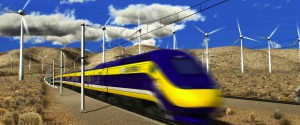By Noel T. Braymer
One has to give credit to the opponents of the California High Speed Rail Project: they never give up. But they haven’t had much luck stopping the California High Speed Rail Project either. There was excitement about the many lawsuits against the project which did delay it by over a year. Yet now almost all the lawsuits have been dismissed with little to show for it for the High Speed Rail opponents. There has been much talk about how horrible the High Speed Rail Project would be and of the Public Outrage for this “boondoggle”. The High Speed Rail opponents got very excited about their petition drives to place a ballot measure to overturn the 2008 Prop 1A measure allowing almost $10 billion dollars in State Bonds for High Speed Rail.
Despite all the excitement of the High Speed Rail opponents, not enough people signed the petitions to get any anti-High Speed Rail Ballot Measures on the ballot in California. There was hope by the High Speed Rail opponents that last year’s Gubernatorial Election would see High Speed Rail become a major issue to hurt Governor Brown’s reelection bid last year. The Governor won reelection handily with little campaigning. As a partisan issue, California High Speed Rail is finding broad bi-partisan support in places that want economic growth and land development.
The latest scare tactic from the opponents of California High Speed Rail is the claim that the project doesn’t have enough guaranteed funding to build the project and the taxpayer will get stuck with the entire bill. This assumes that the project should have all the money upfront before starting construction. Most major public projects don’t have full funding before the start of construction. Much of the money is budgeted for the future as needed. The question should be who has all the money upfront for any major purchase? If you could find a house for $300,000, how many middle-class families would have that much cash to buy a first house? The answer is almost no one. Most houses are bought with a mortgage, by borrowing money. Most major economic activity is based on borrowing money. All businesses depend on credit for their capital investments, which are later paid off with future profits.
The opponents of High Speed Rail claim no one will privately finance this project. Yet the California High Speed Rail Authority has been contacted by several firms that are very interested in financing construction for California High Speed Rail. The opponents claimed these business are in the construction, not the finance business. Turns out these firms are in both businesses and often finance their construction projects. What most lenders are interested in; is if borrowers have the cash flow to make payments. With future funding from Cap and Trade will come the cash flow to make payments on future loans for construction.
From the very start, the California High Speed Rail Project was planned as a Public, Private Partnership or PPP. PPP’s have been used to build many major capital projects including High Speed Rail in many parts of the world. PPP’s include both Public and Private financing with for-profit operation of service. Private investors like being involved with PPP’s since it reduces their risk for lending . In general financing transportation projects are considered safe investments by investors. Governments use PPP’s to build projects using private funding to reduce dependence on tax funds.Former British Prime Minister Margaret Thacher was an early supporter of PPP’s projects.
When the first commercial High Speed Rail train runs in California, the operator will be paying the State money to run the trains so they can make money by running the trains. This is common in many places around the world. High capacity passenger trains usually operate at a profit. Plus the California High Speed Rail Authority will have other sources of revenue from joint use of their rights of ways and from development around their stations.
So will people ride trains in California? They already are in many places in California. California’s population is already nearly 40 million people and is still growing. Good transportation is central for economic growth and trains can carry a great number of people while not adding to traffic or parking problems in major cities. With High Speed Rail taking over much of the local commercial air traffic, this will free up airspace and gates for more, longer distance and more profitable air service,
The opponents of California High Speed Rail love to disparage the claims of the California High Speed Rail Authority, But so far the opponents of California High Speed Rail have a terrible record when it comes to being right. They have underestimated the support for High Speed Rail in California. They have grossly overestimated the opposition to High Speed Rail. They didn’t succeed in their vaulted lawsuits which brings into question their understanding of the law. They claim this project won’t get private funding despite several interested investors for California High Speed Rail. High Speed Rail is often profitable in most parts of the world and major drivers of economic growth despite claims to the contrary. Given the track record of the opponents of High Speed Rail, it is hard to give them credibility for their doomsday claims.
